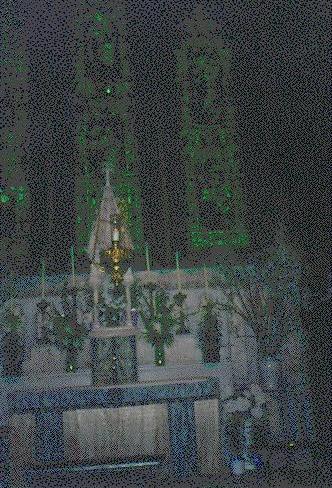|
Church of Saint Mary the Virgin
139 West 46 Street, New York, NY 10036
(212) 869-5830 Fax No. (212) 869-7039
by
Tim Chang
()
History of the Episcopalian Church
This is a short summary of the history of the Episcopalian Church, explaining
its relationship with the Protestant Church of England and the Roman Catholic
Church.
 The
Episcopal Church, founded in America, is based on Roman Catholic and Anglican
ideals. Spiritual discipline and worship services are identical to the
Catholic Church. Thomas McKee Brown, the founder of St. Mary the Virgin
Church says, "The Episcopalean Church is worked upon a thoroughly Catholic
basis...both in ritual and teaching. The ritual resembles of that of a
Roman Catholic church, and it is frequently mistaken for one passers-by." The
Episcopal Church, founded in America, is based on Roman Catholic and Anglican
ideals. Spiritual discipline and worship services are identical to the
Catholic Church. Thomas McKee Brown, the founder of St. Mary the Virgin
Church says, "The Episcopalean Church is worked upon a thoroughly Catholic
basis...both in ritual and teaching. The ritual resembles of that of a
Roman Catholic church, and it is frequently mistaken for one passers-by."
In 1789, the Protestant Episcopal Church (or just Episcopal Church) officially
organized in Philadelphia. To date, the Episcopal Church is still affiliated
with the Church of England which is Anglican. However, since the Episcopalians
have many Roman Catholic ideals like its ritualistic practices of parish
members receiving communion, they have been considerable controversy with
the Church of England and the Protestant heritage that is deeply embedded
in England. The main reason why the Episcopalians have such similar principles
with the Catholic Church is because of a movement in the 1840s called the
Oxford Movement, which stressed the Roman Catholic heritage. During the
later years of the Episcopalian Church, however, the tensions between the
Protestant England diminished. The rift subsided mainly because the Episcopal
Church evolved into a liberal theology, which involves criticisms of the
bible.
The Church accepted most of the beliefs and doctrines of the Church of
England. It embraces both the Apostles' and Nicene creeds. Also, the Thirty-nine
Articles of the Church of England, are integrated into its own prayer book.
The clergy or laity do not have to agree with all of these principles derived
from the Church of England.
As far as its organization and leadership, the bishops run the parishes
much like the Roman Catholic Church only in areas where the Congregations
are not self-supporting missions. However, in each self-supporting parishes,
they elect a lay governing board or vestry for temporal affairs, which
are things like handling the finances of the church. Furthermore, the spiritual
affairs are of course, headed by the rector and the clergy.
St. Mary the Virgin
Main Page | Gothic Architecture at Church of
St. Mary the Virgin | Gothic Architecture and
Engineering | History of the Episcopal Church | Photos | Links | Bibliography | Miscellaneous | Back
to Medieval New York Page
The Internet History Sourcebooks Project is located at the History Department of Fordham University, New York. The Internet
Medieval Sourcebook, and other medieval components of the project, are located at
the Fordham University Center
for Medieval Studies.The IHSP recognizes the contribution of Fordham University, the
Fordham University History Department, and the Fordham Center for Medieval Studies in
providing web space and server support for the project. The IHSP is a project independent of Fordham University. Although the IHSP seeks to follow all applicable copyright law, Fordham University is not
the institutional owner, and is not liable as the result of any legal action.
© Site Concept and Design: Paul Halsall created 26 Jan 1996: latest revision 12 April 2024 [CV]
|